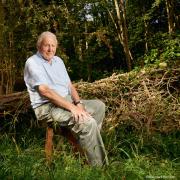With increasing urbanisation, our gardens are becoming ever-more important habitats for birds, providing them with food, water, shelter and nesting opportunities. Here’s how to do your bit for the local birds in Kent this winter
Kent’s gardens are perfectly positioned for a range of different birds. If you’re lucky, you may have some of our winter migrant thrushes visit your garden.
Results from BTO’s Garden BirdWatch (GBW) show that on average only two per cent of Kent gardens will see Redwing at this time of year, but in years when there is severe weather this can increase up to a third.
Long-tailed tits are also prevalent in late winter. They travel in flocks and constantly chatter away, making them a welcome addition to the garden.
On average, about a third of Kent’s gardens get them at this time of year, but in particularly cold weather, they will move through gardens in much higher numbers.
Back in the early 1970s, the Siskin was an unfamiliar species to many birdwatchers, restricted to areas with large conifer plantations. Now it is a familiar winter visitor to many gardens, especially when the abundance of conifer seeds is low.
In Kent, an average of 10 per cent of GBW gardens see them in late winter, but in harsher weather this can reach 30 per cent.
Feeding the birds
As a nation, we love feeding birds in our gardens. It is estimated that up to 75 per cent of households provide food during the year, and the BTO’s Garden Bird Feeding Survey has shown that the average number of species seen in gardens over the winter has risen from almost 16 in 1970 to a high of over 22 in 2010.
There are now a number of foods available to entice birds into your garden:
? Sunflower seeds: attract most species. Sunflower hearts are more popular than seeds due to the fact that birds do not have to husk them. They are more expensive, but produce little waste.
? Seed mixes: cheaper mixes often have a high proportion of cereal – popular with sparrows and pigeons – but those with lower grain content are more suitable for finches.
? Peanuts: make sure they are high-quality and provide them in a mesh feeder.
? Fats: energy rich foods that are popular, especially in the winter. Remove the nets from fat balls as these can pose a danger.
? Nyger seed: a specialist food that may attract goldfinches, siskins and lesser redpolls.
? Mealworms: great for ground feeders such as robins, wrens and blackbirds.
? Wate: always make sure there is
drinking water available.
Getting bird friendly
While feeding the birds is a great way to attract them into your garden, making your garden more bird friendly may encourage them to stay.
There are some plants that provide many different needs for birds, so if you don’t have much space in your garden, consider some of these.
Yew, hawthorn, holly and ivy can all provide cover, protection for nests, and berries for thrushes in the autumn and winter.
Hawthorn and Ivy also have the added benefit of being popular with pollinators, in turn providing food for insectivorous birds. For seed-eating birds, you can provide species such as beech, dandelion, teasel and sunflower. n



























